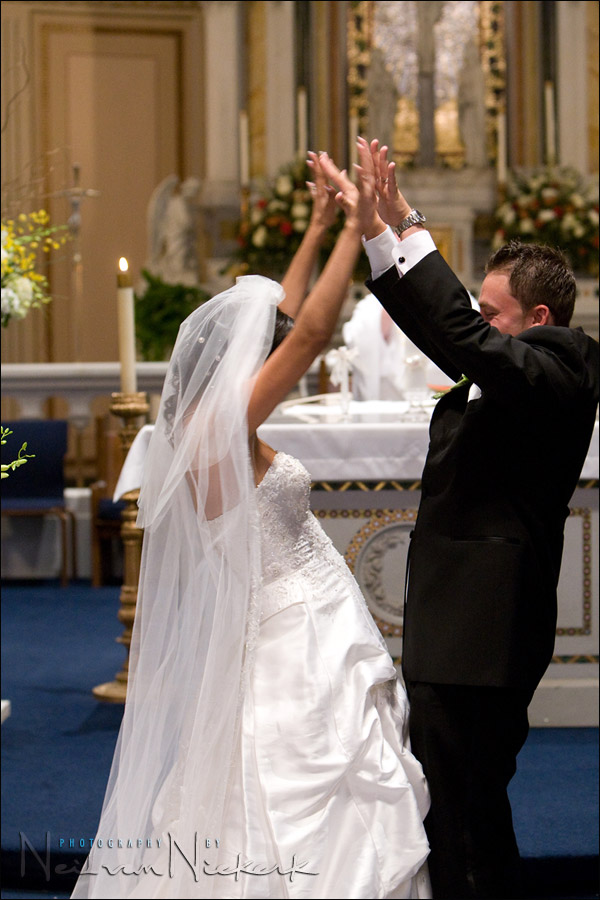
This was a first for me – a couple who high-five each other after the first kiss!
(This was from a wedding last year.)
My settings : 1/100th @ f3.2 @ 32oo ISO.
Yes … 3200 ISO. I couldn’t use flash and I needed a hand-holdable shutter speed with the 70-200mm zoom. Even though it is a stabilized lens, I do need a shutter speed that is fairly fast to stop any movement. (Or stops movement enough.)
So why this photo?
Choice of ISO settings for wedding photography
Well, I frequently get asked how I deal with high-ISO noise, since many of the photos are taken at ISO settings over 400. The answer might be surprising … I usually don’t. Even though I own both Neat Image and Noise Ninja, (both excellent pieces of noise reduction software), I rarely find the need to run any images through these programs.
Personally, I use the entire ISO range available to me on my cameras. Fair enough, I do use digital cameras that are at the top end of the spectrum and they do allow me to use very high ISO settings with ease. (Currently these are the Canon 1D mk3 and Canon 5D and Nikon D300.)
And to show that I do indeed use the entire range of ISO settings available to me, here is a screen-grab of my window in Bridge where I edited images from a wedding that I would to give to the client.
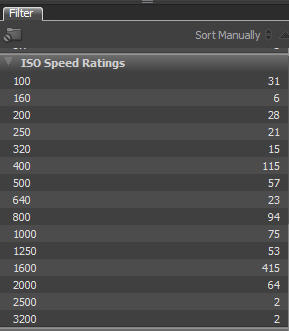
So yes, I do hop between different ISO settings. I change my ISO nearly as often as I change my shutter speed and aperture. This is a notion that I think many photographers still have to get used to … that the ISO setting is another control that can be varied at will.
Back to the high-ISO noise aspect:
How noise appears depend a lot on what camera you use, whether you’ll notice noise at 800 ISO or 1600 ISO … and then more importantly you have to consider what size you’re going to print to. Also, the crucial thing is not to under-expose. That will definitely show up as a noisy image. But if your exposure is correct, you’re already well ahead in getting an image that has less noise.
That photo at the top of this article was taken at 3200 ISO. So what does the noise look like ?
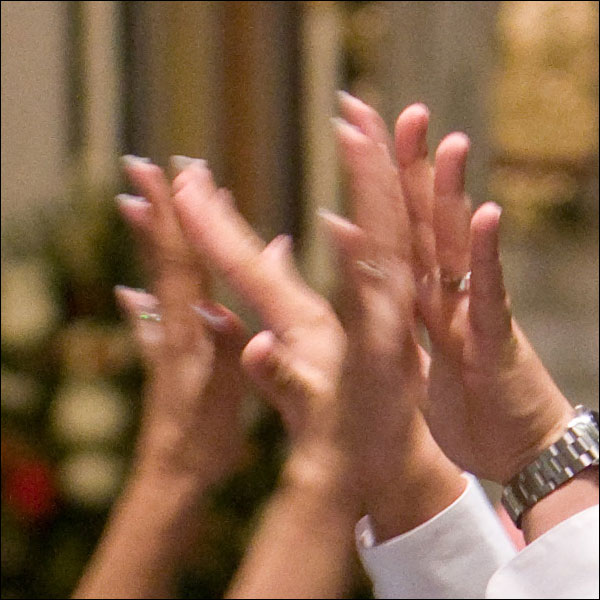
Pretty remarkable actually for 3200 ISO. (This is with ACR in Bridge at the default settings.)
But you know … this isn’t all that relevant in the end.
I have made 8×12 prints that I show potential clients, which include images shot at 1600 ISO and higher without noise reduction software being used … and NO ONE has commented about the noise. If you looked at the prints you would see the noise, but it isn’t intrusive. At larger sizes it might be noticeable, but not really at that size, or for use in an album.
The problem is only really a “problem” if you look at 100% on your computer .. but that isn’t what is going to appear in print. I suspect too many photographers get hung up on the noise issue, without considering what the use of the images will be. But the best way to check for yourself is to make a few prints.
(Once again, the disclaimer is that I do use cameras that allow me higher ISO settings with ease.)
Formal photos / portraits I seldom take higher than 400 ISO … but reception photos I easily go to 1600 ISO and sometimes higher, since they will rarely be printed larger than 4×6.
Looking at two more images which have appeared elsewhere on this blog already :
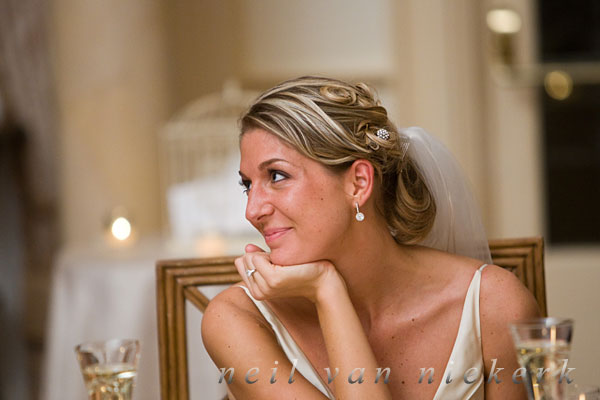
settings: 1/100th @ f2.8 @ 2000 ISO.
.
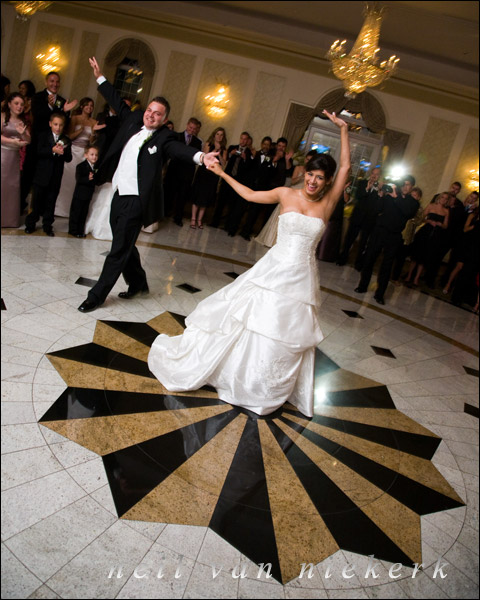
settings: 1/25th @ f4 @ 1600 ISO.
I could show you 100% crops of the images, and you would see some noise .. but again, I’d have to say that doing so wouldn’t be all that relevant except for technical interest perhaps. We need to look at how the images will be used, and where .. and as such, the high-ISO noise is of lesser concern than getting the moment successfully. And that would include using a high enough shutter speed to freeze any motion (if that is the intention), and an aperture chosen such that we have sufficient depth-of-field.
The main reason why I would choose a higher ISO over a slower shutter speed, is that it is far easier for me to correct high-ISO noise (should it be a problem), than it would be if I had an image that is too soft from motion blur or camera shake.
So I’ll easily bump my ISO up even higher if that is what I need to do in order to get the shot that I want.
Many thanks for your very pragmatical approach. I fully agree with your comment. Sometimes we look for the problems, and if we don’t find it, we zoom to 100%, and if not yet, we zoom even more.
Some of my shots at high ISO with good light, have given less apparent noise, than a dark image at low ISO.
I would love to use higher ISO quite often, but in fact I usually can’t get decent images with ISO above 400 (next available value in my camera is 800). Though, after you have noticed, that it is sometimes matter of underexposure, I think that is the mistake I often make while shooting indoor.
I’m also wondering whether difference in noise at high ISO is very significant between professional cameras and low-cost DSLRs. I’m using 400d and a kit lens at the moment (student’s budget :)
Thank for good tips, as usual.
I stopped worry about noise to iso 1600 a while ago, you were right no one noticed except me. I do look however at iso 3200 photos and usually get rid of the color noise in ACR, the other noise 9/10 times looks more like film grain, and that is what I am looking for.
Hi Neil, I agree with your comments on high ISO shooting, I have a D300 and regularly turn out perfectly usable images at 3200 ISO. You mentioned that you don’t use noise reduction software for your images, however I was curious if you have the camera NR turned on. I usually have mine on with the D300 which kicks in at ISO 800. It has the effect of slightly reducing detail, but unless you are viewing the images at 100% on a computer screen you wouldn’t notice that anyway.
Thanks,
Chris.
It is definitely weird to look at images at 100% on my computer, because I clearly see noise on my high ISO images, but I keep forgetting that this is not how most people see the images. Neil makes a good point about not getting stuck looking at every high-ISO at 100%. Thanks Neil.
I know what you mean when you say it is crucial to expose right when using high ISO’s.
I just recently did a test by taking a photo at 400 ISO correctly exposed and a photo at 1600 ISO exposed to the right and brough back down in post processing and it looked the same or better than the 400 ISO image.
I have been using a Canon Rebel XT and the grain gets pretty bad at ISOs higher than 400. I can tell you how much that limits my photography because I end up having to dial down the shutter speed and end up with really blurry photos. I’m waiting for the 5D successor to come out so I can finally have the full range of ISOs to work with. Neil is absolutely right, grain is far better than blurry photos.
In the first picture, you shot with f3.2 which is not the widest aperture of your lens. Did you intentionally avoid using the widest aperture? Isn’t it because your lens is sharper in f3.2 than in f2.8?
In fact my question is: Do you suggest going to higher ISO but use a sharp aperture?
Hi Neil,
When I shoot at ISO 800 and up, I sometimes see those RGB grain in the shadows or dark areas of the image. Is this an indication that my image is generally underexposed? By the way, I use a 30D. Thanks and God Bless! :-)
Hi Neil, I was just wondering if you have your in-camera NR turned on during high ISO shooting?
Thanks,
Christian.
I shoot Canon and the Digital Photo Professional software that comes with the camera has a excellent noise reduction function that does wonders and has advanced in the latest version which is 3.4.1.1.
HI…I recently learnt that underexposed images will lend itself to more noise…I have always been afraid of going higher than ISO 400. After reading this, at a birthday party one night last week in my house, I raised the ISO to 800 and my shots were extremely sharp! I took extra care in making sure the pix were well exposed.
The only noise I noticed was in the BACKGROUND, ( and only when zoomed in to 100% which we now know doesnt matter) not on peoples faces, they were all sharp. Neil, does this make sense?
Neil, just so I understand, why would the background show noise and not your subject (when using a high ISO)?
Hi Neil,
I hear a lot about preferring native ISO’s for having the least noise. What makes an ISO native? I only know it means traditional film ISOs, 100, 200, 400, 800, etc. Do you notice this trend?
Jess
Would it help to shoot in RAW and to slightly over-exposure? The exposure could then easily be corrected during post-processing. By reducing the overall exposure in the RAW conversion also the noise would be reduced.
In terms of Signal-to-Noise (SNR) ratio, I think it should help to increase the singal whilst the noise level remains equal. This could be done by over-exposuring the image by decreasing shutter speed. Am I right? Higher SNR gives better images (that’s why we can see noise better in dark areas)
Since the RAW image provides higher bit-resolution per pixel than the final JPEG does, the above procedure should be no problem.
What do you think?
settings: 1/100th @ f2.8 @ 2000 ISO
And the next image, with an accompanying 100% crop
settings: 1/25th @ f4 @ 1600 ISO.
when you set iso do you set auto iso? and the other settings in manual?
I certainly agree to increase ISO in order to have any kind of shot to work with is far better than one that’s blurry (unless movement/blur is intentional). Great site, I’m glad I found it!
Hi Neil,
I am shooting with a Nikon D700 and am constantly amazed at the images it is capable of at high ISO’s. My question is this, if I need to maintain a fast shutter speed becasue I am shooting a non-stabilized 80-200 f2.8 and I know what specific aperture I want to use to ensure adequated DOF, then could I (or should I) set my aperture and shutter manually but leave my ISO setting on AUTO and simply let the camera select whatever ISO it feels adequate to match my other settings. With cameras like the D700 ISO seems to be of lesser importance than the other two settings. Of course for the formal (wedding) portraits I would set the ISO manually but for the ceremony and reception what is the down side of selecting your shutter and aperture manually and letting the camera select your ISO for you?
Thanks again for a great website.
Ross.
Hi my name it Ray I use Nikon D5000 And lend Tamaron 18-270mm F/3.5-6.3 How i can get the most how i can take i picture like your Wedding on the chair Could you tell me I good DVD Tutorial for Nikon and Photoshop SC6 so I can get the most.
Thank you
Ray